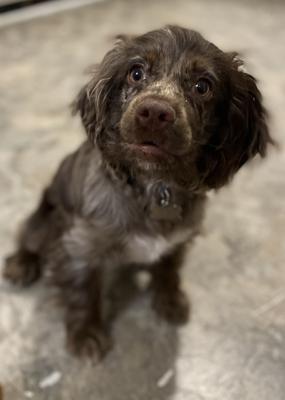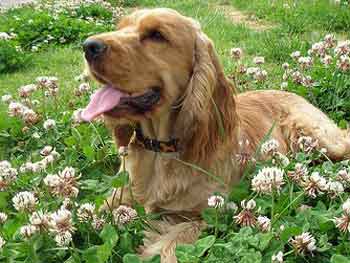- Home
- Grooming a Cocker Spaniel
- Bathing a dog
Bathing a Dog: How to Bathe Your Pet Without Tears and Tantrums!
Bathing a dog doesn't need to be traumatic for either of you!
This handy checklist will show you how your dog's bath-time can be fun! Read on to learn the best and easiest way to bathe a dog.
Bathing A Dog Without Tears!
'Who's tears?' you might ask, 'His or mine?'
Bathing a dog can be stressful, especially if your Cocker Spaniel decides he doesn't want to be washed!
However, giving your dog a bath from time to time is essential to help his coat stay clean and shining, his skin healthy, and to stop him from smelling less than fragrant!
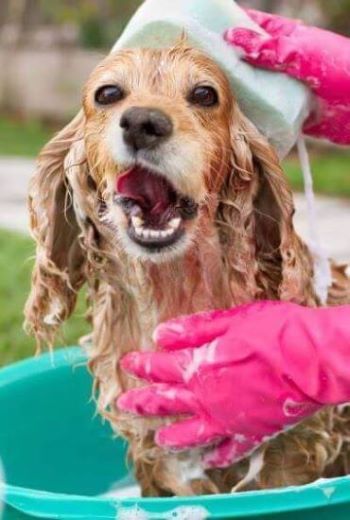 These soap suds taste like flowers!
These soap suds taste like flowers!Learn how to get your dog smelling sweet and looking clean with minimal fuss. I aim to answer your most frequently asked questions about bathing a dog, such as:
- Should I brush my Cocker Spaniel before I bathe him?
- How often should I wash my dog?
- Where is the best place for bathing a dog?
- What bath time essentials will I need?
And then, I put it all together into a simple checklist on bathing your dog.
Best Time to Brush: Before Or After Bath-time?
Some groomers recommend gently teasing out all knots, matting, and brushing the coat before bathing a dog. They believe that if tangles and mats are left in the fur, they'll trap dirt and shampoo and make matters worse by tightening the mats.
Trapped dirt and chemicals (yes, they're even in the gentlest of dog shampoos) so close to the skin can cause skin complaints and can aggravate existing skin conditions.
However, other groomers say you should wash your dog first. They believe that the grit and/or dirt in an unwashed mat or coat will blunt their (costly) scissors and trimmers.
I like to remove tats and matting before I bathe my Cocker Spaniel, give him a quick brush, and then brush him thoroughly afterwards. However, this is entirely a personal choice.
Decide for yourself which way around you prefer to do it, bathing your dog first and then brushing him or the other way around. Whatever you decide, it's not life-threatening!
Whichever way you choose to do it, brushing your dog is an essential part of his grooming schedule as brushing helps remove dirt, loose hair, tangles, and most importantly, brushing removes the dead hair from the dog's undercoat.
If this isn't removed regularly by brushing, it will eventually clump together and cause matting.
Apart from helping you and your dog bond, brushing also gets the circulation going and helps distribute natural oils evenly around his coat.
How Often Should I Bath My Dog?
Your Dog's Lifestyle
Your pooch's lifestyle can help you determine how often you should be bathing your dog.
For example, if your Cocker is very active and free to run around in the countryside, his coat will undoubtedly collect half a ton of vegetation, picking up burrs, leaves, bits of twig, and other debris of dubious origin.
If your dog is lucky enough to swim in the sea, rivers, or even if he romps through all the muddy puddles he can find, it probably means that bathing your dog will be a reasonably frequent event in your household, especially if he enjoys rolling in muck!
(And they do, don't they? Max loves to roll in fox pee, which has a particularly unpleasant aroma!)
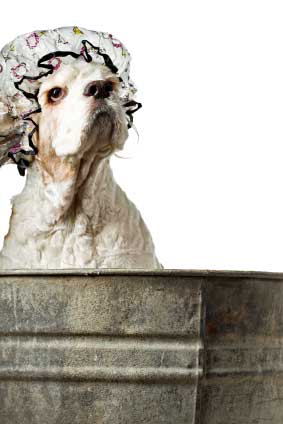 I'm ready for my bath now mum!
I'm ready for my bath now mum!On the other hand, if your Cocker Spaniel is getting on in years, he may be relatively sedate and content with just a little gentle exercise in the garden or a short stroll along the pavement. In his case, bath-time may only be required once every three months.
If this applies, lucky you!
Type of Coat
The type of coat your pet has is another factor in determining how often you should be bathing your dog.
If his coat is heavy or thicker than usual, your Cocker may need frequent baths to keep him clean, but dogs with shorter, smooth hair may not need to be bathed so often.
Cocker's coats are naturally water-repellent, and bathing a dog too often could be harmful because it will strip the coat of its essential oils and cause dryness and irritation, leading to skin disorders.
Keeping bath-time to a minimum will help preserve those essential oils that keep his coat waterproof.
The Sniff Test
If you have any doubts about when to wash your dog, this very scientific test can help.
- Ask your dog to sit in front of you
- Get down to his level
- Lean over him and...
- sniff deeply!
If he smells bad, it's bath time - very scientific!
Best Place For Bathing A Dog
When the weather's warm, you can bathe your dog outdoors in the summer. Simply lather him up and hose him down!
I don't recommend bathing a dog outside in winter. It's not safe as the water will be too cold for your pet. It's probably okay to use the hose to wash off the mud from his paws and legs, but make sure you get him indoors and dried off quickly.
When bathing a dog indoors, always use lukewarm water; common sense tells us that hot water can burn his skin, but it can also cause dryness and irritation.
Either way, too hot or too cold water can make bath-time a miserable experience for your dog.
If you have a bath for your Cocker, it can be placed at a level to suit you (and your back!) and can be set up in a garage or a shed.
For me, the bathroom is ideal; even better if you have a utility room. Both rooms offer easy access to warm water sources and can be easily cleaned afterwards.
My Cocker, Max, is such a 'muck magnet' and always seems to find the muddiest places to roll in.
When he gets really messy, I carry him through the house (cream carpets!) and dump him into the shower. Here, he can shake himself as much as he wants to - all the muck, soap and water are contained within the shower cubicle - keeping the rest of the bathroom clean!
However, it does mean that I have to take a shower with him!
Best Bath-Time Essentials
Dog Shampoo
There are many types of dog shampoos available for bathing a dog; medicated, treatments for fleas or skin conditions, beautifully scented shampoos; shampoos containing Aloe Vera to soothe the skin, conditioning shampoos, dry powder shampoos, and many more.
Bathing a dog with good quality, tear-free dog shampoo or conditioning shampoo will help keep your Cocker's coat clean and healthy-looking, and it will also take good care of his skin.
Don't be tempted to use shampoos formulated for humans, except perhaps for no-tears baby shampoos, as all others will be far too harsh for him and may cause skin complaints or trigger allergies.
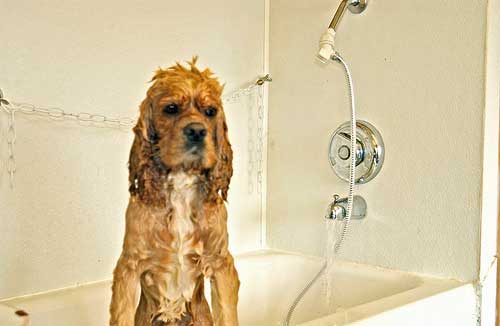 Bathing a dog that's not very happy!
Bathing a dog that's not very happy!If you're unsure which to use, or if your pet has skin problems, why not ask your vet or groomer to recommend a more gentle shampoo?
If you're using a medicated shampoo, only use it as prescribed by your vet.
Trying to get the shampoo into all areas of your dog's coat can be a real challenge. However, this great tip will help you to do just that.
Use an empty bottle, pour in enough shampoo for one wash and top it up with water. Put the top on and give it a shake to mix it up. Approximately 10 per cent of shampoo to 90 per cent of water works very well.
Using a bottle to dilute the shampoo with water before using it on your Cocker's coat helps the shampoo lather up much more quickly and easily. The shampoo lasts longer too!
I don't recommend diluting medicated, or flea treatment shampoos as this will reduce their effectiveness. Use as advised by your vet or the instructions on the packaging.
Bath Mat
A non-slip bath mat is essential to stop him from slipping and sliding in the bathtub when bathing a dog.
It will help your dog feel safer and prevent him from hurting himself.
Bath Towels
Have two or three large fluffy towels nearby; two to dry him off with, and another to wrap him in or lay on later until he's thoroughly dried off.
A Handful Of Dog Treats
When bathing a dog, I think it's advisable to keep a couple of treats handy. Giving your Cocker a small treat two or three times during his bath may help keep bath time fun and rewarding for your Cocker Spaniel.
A Shower Hose Or A Large Plastic Jug
A shower hose on your bath will make it easier for you to rinse him thoroughly, but a large plastic jug will do just fine.
Sink-Hole Protector
If your Cocker Spaniel's coat is heavy or moults quite a lot, it may be time to invest in a sink-hole protector to catch fur and hair; otherwise, you may create a blockage.
Bathing A Dog: A Simple Check List
Before bathing your Cocker Spaniel, collect everything you need, towels, shampoo etc., and put them within easy reach of your bath.
- Collect your dog, bring him into the bathroom and close the door behind you in case your dog feels like making a bolt for it!
- Place your Cocker Spaniel in the bath on a non-slip bath mat.
- If he's not yet familiar with being bathed or is still a puppy, I recommend you carefully introduce him to his bath time.
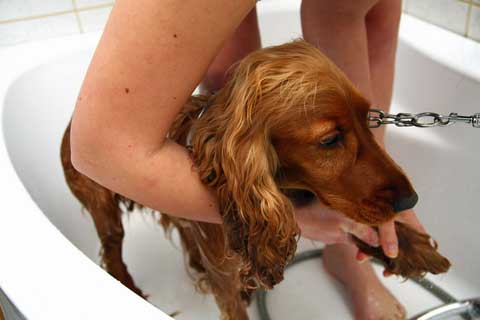 Oh no, not bathtime again!
Oh no, not bathtime again!- If your Cocker's a wriggler, you can use a short nylon collar and lead (never leather) and link it to a handgrip (if your bath has one) or a tap. This will give you the freedom to use both hands and will help to make the job much easier!
If you decide to use a lead, the lead must be short enough to make it impossible for your dog to jump out or over the edge of the bath. You don't want to choke your dog accidentally!
- You might like to place a cotton wool ball inside his ears to
help keep water out of the ear canal. Try not to get them soaked because the cotton wool could act as a wick instead of keeping the water out of his ears.
Just take extra care around your Cocker Spaniel's ears when rinsing.
Wetting Your Dog
- Test the water to make sure it's not too hot. You don't want to burn your Cocker's skin.
- Gently spray his body with warm water.
- Don't wet his head and ears at this stage as he will only shake himself and cover you with water!
Time To Lather Up!
Only shampoo your dog once unless he's really, really dirty, in which case you can give him a second lathering.
- Shampoo his hind legs first, then his bottom and tail.
- Move on to the body, underbelly, chest and front legs when you've done that. Don't forget your dogs paws and in between his toes.
- Try not to use the shower spray directly on your Cocker Spaniel's face or genitals unless the water pressure from the spray is very gentle.
- Smooth the shampoo into the coat in the direction that the hair grows and gently massage. Be careful not to rub too vigorously; otherwise, you may create knots and matting.
- If your Cocker Spaniel has short hair (i.e. his coat is trimmed using trimmers and not hand stripped), you can massage and lather the shampoo without worrying about creating tats.
- Bathing a dog should be fun, not a stressful exercise for either of you, so keep things light and easy. Praise your dog quietly as you work. It will help your Cocker Spaniel to enjoy his bath time, and it will also strengthen the bond between you.
Wetting Your Dog's Head
- When you've finished washing his legs, tail and body, you can now gently wet his head, face, and ears.
- I usually wet each ear first, inside and out, but never allow water into his ear canal.
- I lift my dog's face up slightly to allow me to wet his head without water running into his eyes, and I use a small washcloth to clean around his eyes and muzzle. It's much easier, and I think Max prefers this to having soapy water poured onto his face.
- Apply the diluted shampoo solution carefully and lather the top of his head his ears, but be very gentle. Don't forget to soap behind and under his ears and chin.
Rinse Your Dog Well
- Thoroughly rinse the soap from your Cocker's head and ears and follow up with his body and legs, not forgetting his underbelly.
- Remember to keep the spray away from the inside of his ears, away from the ear canal.
- When you've finished rinsing him, rinse again. If there are any signs of lathering as you glide your hands over your dog's body, his coat is not yet thoroughly rinsed.
- Continue spraying him with warm water until the water from his coat runs clear. You don't want to leave any soap residue in your dog's coat.
- When you've finished rinsing, gently squeeze as much water out of his coat as you can and then quickly throw a towel over him to stop him from shaking himself.
Dry Him Off
If you dry your Cocker's head and ears first, it may stop him from shaking. Try it!
- Towel dry thoroughly but don't rub too vigorously; otherwise, you may cause tangles and matting. Besides, Cocker Spaniels don't like 'rough handling', so gently does it!
- Gently squeeze the feathers and his fur in the towel, which will help absorb excess water.
- Use the dry towel to pick him up and take him into another room where he can be warm and lie on the towel to dry off.
Some dogs go crazy after having a bath, dashing and rolling around. For this reason, (and you want to keep him warm), I recommend you don't let your dog outside; otherwise, he'll end up dirty again!
My dog Max goes mad after his bath. He runs for the nearest rug or towel and slides his face along the floor (alternately rubbing each side of his muzzle) with his bottom stuck up in the air and will then roll around on his back, kicking his legs happily. This is quite amusing and so endearing to watch!
After bathing, many professional groomers use hairdryers (or crates with dryers) on their dogs. If you like, you could use a hairdryer on him (on a cool/warm setting) but make sure you don't get too close, or you may burn him.
Max is quite the little hedonist; he loves being dried with a hairdryer, lying on the floor in ecstasy, and often falling asleep!
Confident About Bathing Your Dog?
After reading my advice on bathing a dog, I hope you're now more confident about the whole bath-time process. However, if you're still unsure about any aspect of how to bathe a dog, perhaps a chat with your groomer would help?
You can now go on to learn about grooming your dog here.
Photo Credits for Bathing A Dog:
1. Jamesbenet at http://www.istockphoto.com/stock-photo-19393627-cocker-female-dog-having-a-bath.php?st=e41b8a0
2. Debbi Smirnoff at http://www.istockphoto.com/stock-photo-17030543-bath-time.php?st=e41b8a0
3. Chris Lester at Flickr.com
4. Lukaz Tymszan at https://www.dreamstime.com/stock-photography-bathing-dog-image7876922





